My little boy is in the featured image. He has a dozen swords from a junior epee to Ultrasabers lightsaber to nerf zombie swords in his collection so he can get daddy. His mask is an Italian fencing mask for kids.
This post is dealing with the equipment that I own or that I am waiting for delivery with an addendum for maybe buys in the future. I included some exercise gear and my books. I post new gear as I get them so reading this may get a bit confusing as it spans more than three years of purchases and I rarely rewrite my reviews unless something changes greatly.
I would like to thank the reviews people like Matt Easton at Schola Gladiatora, David Rawlings at London Longsword, the gentleman at Hema Reviews, Skallagrim, Aidan Blake, the review teams at Blood and Iron, the guys at R/Hema who made the gear list, and the fine folks at Measure and Weigh. I have replaced a few bits of gear that weren’t working out for items they reviewed with a high opinion particularly the Measure and Weigh reviews. You guys really make it a lot easier for all of us when you share your insights with us beginners so we can avoid at least some of the pitfalls of starting Hema. If people don’t say thank you often enough I’ll just say thank you for a second time just in case.
Don’t forget to clean and care for your gear. Sometimes that means a visit to a competent dry cleaner or a bit of Febreze or Cleargear or hand washing in lukewarm water with mild detergent. Odor Gladiator is a good add on for your gear bag.
Speaking of gear bags I find that I get good mileage out of a cheap snowboarding bag {upgraded to a mesh bag for better airing out of my gear from club to house}. If I was traveling on a plane I would probably get a hard “Sportube” or a hard case Samsonite as I’ve heard they are great.
Don’t leave your gear in direct sunlight or damp area for too long. Baby wipes are great for plastic bits. Proper care of steel is important to avoid rust. Always ask your smith for the best care for your blade if you can as they should know best practices and tricks for longer life and aesthetics.
Books:
The most precious piece of gear to have for HEMA are books! So, book reviews are what I’m going to start off with. For freely available pdfs and links to books on the net check up my One Year Anniversary Post above for links to hundreds of articles, books, and other resources for the budding Hema student. Remember to give reviews and help authors and shoppers find good products.
Historical European Martial Arts in Its Context: Single-Combat, Duels, Tournaments, Self-Defense, War, Masters, and their Treatises by Richard Marsden Amazon
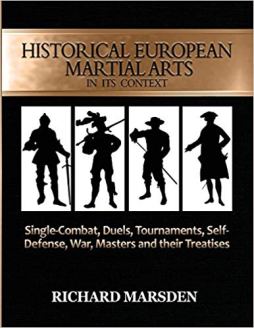
People new to HEMA should definitely read this extensive Primer on the how and why historical martial arts developed in Europe is packed with lore about the development of HEMA and its Context (looks around for Matt Easton).
Studying this will fill in the gaps of knowledge in most experienced fencers and lay strong foundations for a novice looking to know more about the world that created these forms of combat and the feedback loop of the form of the weapon and the techniques used with that weapon.
The book begins with the history of the duel in various parts of the world and goes on to cover tournaments, self-defense, wars, and the various masters. I enjoyed the latter half of the book the most as the beginning was sometimes a bit dry so if need be you can bounce around a bit. Someone with a bit of grounding in fencing might gain the most by reading the Masters and their treatises first and then coming back to the beginning.
One thing that I would have really liked would be a Kindle version that you can purchase along with the hardcover as this book is about 15% footnotes it is so well researched which would be easier to check on in an online format. The addition of easily clickable links would make tangent surfing of the bibliography and footnotes far easier as some of those URL’s were very long. Tangent surfing is my term for when you see an interesting tidbit and read up on it and then follow where it leads and suddenly you’re reading about Cerenkov radiation when you began the tangent surfing reading about Alhazen’s problem.
I could see authors, game developers, and fencers really gaining a lot of data from this book and because of its extensive footnotes following the rabbit trail to a wider understanding of historical martial arts. Plus, if you’re looking for a new treatise to read just go through the masters in the back until you see one that tickles your fancy and then delves from there.
Highly recommend.
Cutting with the Medieval Sword: Theory and Application: by Michael Edelson Amazon
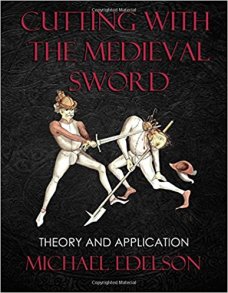
A very valuable resource for anyone wanting to learn how to cut properly with the correct biomechanics with a sword. I’m not done reading it yet and I’m only about a quarter into it and have already learned quite a lot. It is hard to resist the temptation to bounce around and all the pretty sword pictures by Albion are distracting. Get it.
<Edit> From my Amazon review after completing the book: A very valuable resource for anyone wanting to learn how to cut properly with the correct biomechanics with a sword. When reading It is hard to resist the temptation to bounce around and gaze upon all the pretty sword pictures. One thing that I really like is the clear and concise advice and insights that bleed over into your fencing regardless of tradition or school. I bought it so I could be better at cutting but I think I am a better martial artist after reading this book. Get it. </Edit>
Treatise Historical Fencing Manual: Rapier-fencing in the 17th and 18th Centuries by Francesco Loda Amazon
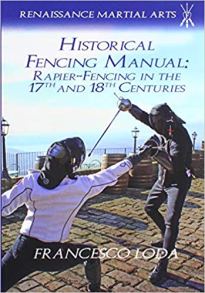
Absolutely lovely rapier fencing manual using the various masters of three schools in southern Italy in order to create a syncretic or synthesis of those schools for ease of learning. This is ongoing research so I hope to read book two when it comes out.
The book is clear and makes every effort to cya while also condensing a lot of confusing terms and POVs into one overall vision of the fencing tradition using the single rapier primarily and the rapier and dagger secondarily.
The footnotes are detailed and interesting by themselves. One could go deep into the HEMA rabbit hole by following them.
The pencil drawings are wonderful and one of the best parts of the book. I didn’t see an attribution to who did them but kudos! I would have loved more of them particularly at the end of the book with rapier and dagger.
I’m still rereading parts and not completely grokking everything but I’m getting a slowly resolving picture in my mind about how it all works. Without a teacher or someone to regularly fence with a rapier against it is much harder but I can see much that is transferable from other traditions and to other traditions.
The idea to not create double angles is key and I really liked the idea or mental concept of the Incontro Perfetto as it is really hard to notice if you’re a novice fencer and to avoid those hits of the two widows and doubly hard to do something about it if you do notice. By thinking about it in subjective terms rather than objective it puts the onus on the perception of the fencer and ironically changes the perception of how you perceive your fencing…or I might just be reading too much into it.
I highly recommend purchasing this if you’re new to rapier or have only read the various masters of different lands for a varied but coherent perspective that is gained not from a singular vision but from a shared creation over centuries and a larger region. Thus, you can lessen the unevenness that often comes from provincial genius and any glaring weaknesses in the style can get patched from many sets of eyes and experiences. I think I will be digesting this for a while!
P.S.
One nitpick is that several times the word “lunch” is used instead of launch which is an editing error that is a bit funny if taken seriously though a meal after fencing is great!
P.P.S.
On page 80 I was a bit confused by this sentence: “With a rapier, the cuts will be less powerful than those made with swords of the 17th Century.”
Since the rapier is a sword of the 17th Century I was assuming that if you replace 17th with 16th then you would then get into “sideswords” which are better cutters and then the sentence makes sense to me or if the sentence was somehow comparing 17th-century rapiers to 18th-century rapiers or a smarra?
Treatise on the Subject of Fencing: Marco Docciolini’s 1601 Fencing Treatise: by Marco Docciolini (Author), Piermarco Terminiello (Translator), Steven Reich (Translator) Amazon
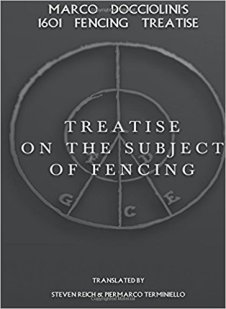
Only about halfway through but I am enjoying reading it. It reminds me of Liechtenauer in that it is very straightforward and focuses on being simple without flourishes or fanciness. Very matter of fact. It would be nice if the book had a longer foreward that went a bit more into history on the period and maybe an index with some insight from the authors on how the treatise could be used in a modern HEMA context. I did find this on HROARR which was interesting to read about dual sword use. I will probably look for videos to help me understand the author better.
<Edit> I did finish the book and it was enjoyable though I might not recommend it as the first book for a beginner with a rapier as the lack of pictures and the lack of resources online to find extra info or to answer questions makes it problematic compared to a treatise by a more well-known author. Alfieri would be my first read, then Giganti, and then Docciolini would be a better reading order I think.</Edit>
La Scherma: The Art of Fencing, Francesco Ferdinando Alfieri: by Piermarco Terminiello (Author), Phil Marshall (Author), Caroline Stewart (Author) Amazon

Very clear and easy to understand treatise. Loved it and the overall layout. Definitely a good value if you’re new to rapier and want to get some good fundamentals. Alfieri focuses on a single rapier for most of the book and then gives some good advice on expanding that with a parrying dagger and some really interesting plays with a cloak.
Self-Defense for Gentlemen and Ladies: A Nineteenth-Century Treatise on Boxing, Kicking, Grappling, and Fencing with the Cane and Quarterstaff: by Colonel Thomas Hoyer Monstery (Author), Ben Miller (Editor) Amazon
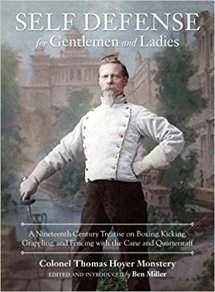
I love the history and story of the first half of the book. Colonel Thomas Hoyer Monstery seems like such an interesting individual and his students include some surprisingly famous individuals. If a competent tv team took him or Jaguerina on as a tv show that would be amazing. The second half is the Colonel’s actual treatise which is worth reading from my limited understanding of the material. I would’ve liked an addendum with a modern practitioner’s point of view and perspective on using the techniques, learning them, teaching them, and applying the lessons of the book in a modern Hema context and perspective.
Nicoletto Giganti’s The School of the Sword: A New Translation: by Nicoletto Giganti (Author), Yvonne Rogers (Illustrator), Aaron Taylor Miedema (Translator), Tara Lynn England (Translator), Kim Reynolds (Translator) Amazon
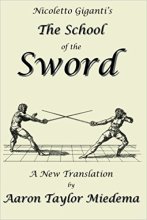
Seems well made but I have to say that I didn’t enjoy the book as much as reading Alfieri and if Docciolini had pictures I would rate it much higher. It is nice that it has so many plays shown and good artwork so you can see what is going on clearly and it is a good solid book to build on your skill.
The ‘Lost’ Second Book of Nicoletto Giganti(1608): A Rapier Fencing Treatise by Piermarco Tierminielo (Translator) and Joshua Pendragon (Translator) Amazon
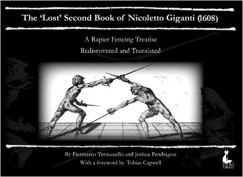
Clear and concise instructions on how to fence well in the Italian style. Covers more weapons and off-hand defensives than his first book such as rotellas, targas, and cloaks. I particularly like the extensive footnotes at the end of the book.
A Gentleman’s Guide to Duelling: Of Honour and Honourable Quarrels: by Vincentio Saviolo and edited and presented by Jared Kirby. Amazon
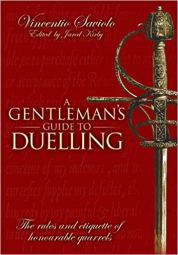
This book is full of insight into the mind of a man at arms and gentleman from Italy living in England during the time of Shakespeare (who was influenced by it) in the late 16th century. I breezed through the first half of the book until I made it into the section about lying and dealing with lying which was a bit dense. I love the term dis-beast he uses to describe gentlemen using reason to handle their emotions and apologize when they’ve done wrong. Saviolo also goes into detail talking about the Nobility of Women whether by words, deeds, reason, or arms which just puts Swetnam in especial consideration and puts the lie to the apologists of misogynists of later periods using the excuse that it was the norm for their time.
I would really recommend the book to writers, screenwriters, and playwrights so they can better capture the code duello and the vast importance of hierarchy in historical pieces or fantasy stories. If you’re building a system of honor for a science fiction novel it would also be useful to accurately know an honor system rather than a flawed Hollywood system. For example, Saviolo gives examples about how one should be prepared for betrayal by being armed and weapons in hand or how it can be considered noble to allow an opponent to re-arm themselves if you win and an act of stupidity if you lose. Basically, he was very pragmatic and not a bit like “honor-bound” men like the Stark’s in Game of Thrones.
Lessons of the Broadsword Masters: Essential Skills of Broadsword Fencing: by Christopher Scott Thompson (Author) and Bob Giordano (Illustrator) Amazon
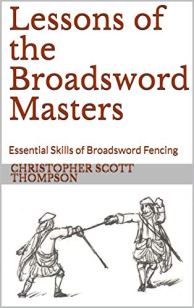
Wonderful book that synthesizes the various broadsword masters to make an introduction into the field for a newcomer. In addition to the overview, it provides a wealth of lessons and practice material both for the solo practitioner and to practice with another student. The MacGregor Method and the Seven Words were really interesting as well. Pair this with some of the excellent youtube videos by Jay Maas at Broadsword Manitoba and you should be able to grok enough about singlestick, broadsword, and backsword to not embarrass yourself at a tournament.
Scottish Fencing: Five 18th Century Texts on the Use of the Small-sword, Broadsword, Spadroon, Cavalry Sword, and Highland Battlefield Tactics: by Jared Kirby, Paul Macdonald, and Ben Miller Amazon
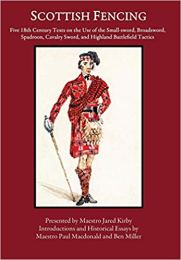
Really enjoyed learning more about the lives, tactics, and strategies of various Highlanders and their works. The first treatise is quite dense but full of useful information if you wanted to know more about how Highlanders fought in formations and their tactics. Later texts cover a fencing dictionary of the 18th century, an advanced course of historical fencing instruction in broadsword, spadroon, and smallsword, a cavalry text, and some research on the life of Donald McAlpine who taught backsword during the American Revolution.
Plenty here for the scholar looking for some first time publishing info and for the historical fencer wanting to learn more about the period that the treatises they study were like.
An enjoyable and quick read from the pov of a 19th-century French fencing master deep biases which are interesting in how they compare to the biases of most experts of today. The conclusions are as interesting as the perspective and remind me of some of the English victorian thinkers whose biases twisted reality in many surprising ways. As long as this isn’t your first exposure to historical fencing I think you will evade these biases with ease.
The main part I enjoyed were the short bits talking about the Dame Knight Eon and the great St. Georges both of whom deserve an HBO mini-series or big blockbuster movie. A master transgender? spy and a black fencing master regarded as one of the greatest swordsmen of history while also being such a great musician and rival to Mozart that Mozart made a caricature of St. Georges as a villain in one of his pieces.
The book is quite short and a quick read at an hour or two. It is well footnoted and researched and the translation reads very smoothly.
An early 18th-century gloss on teaching fencing. I particularly liked and agreed with de Brye’s recommendation of training in the later steps of practice as the student gets more skilled against the “vigorous unskilled” in order to prepare your art more effectively. I also liked his attempts to demystify martial mastery. A good read for anyone interesting in teaching fencing or historical fencing.
Fencing treatise from a son of Provence this is a strange book with sonnets praising the author from various notables to a large focus on drawing or unsheathing your sword.
It even explains some fencing using 16th-century tennis. It is I think trying as the translator mentions to train courtly beginners in how to fence at court. The book also could be seen as training a beginning tutor in how to get down to the essence of what to teach while being strangely ambiguous and nebulous in terminology.
I would have preferred the plates integrated with the text rather than collected at the end.
Still parsing in my mind what I think about the treatise. I feel the translator did a good job of making things as clear as possible with the limitations of the original wording.
Worth reading if you’re interesting in historical fencing and inexpensive in the kindle format for what you get making it a good value. HEMA books can eat up the pocketbook very quickly.
GEAR:
Gajardoni Ancient Air Mask
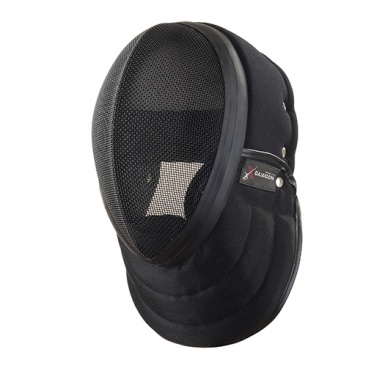
This mask is very protective and comfortable. It has a cool gimmick that does militate a hit to the upper head a small amount by pumping air into little bladders built into the padding like those old basketball shoes in the 80s. The main benefit is in helping the fit better match your head and mold a little bit better to your head in my opinion versus actually protecting you in a significant fashion. The ridge the splits the face bilaterally does a great job at dispersing the kinetic energy from certain types of hewing hits and helps make a full-on thrust to the center of the face skitter off either to the left or right rather than sending the energy full on pushing the head and neck back.
I have a giant head so they were nice enough to provide a double-sided velcro strip to act as an extender to the back straps to fit both my huge head and the included back of neck protection.
You can buy it here: Ancient Air Mask
Spes Officer Jacket
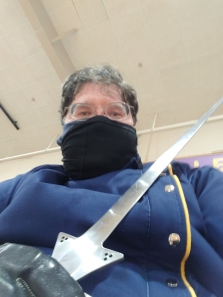 This is my main jacket as of 2020 that I use for fencing practice. With longsword I make sure I use my forearm protectors otherwise bruises are going to be bad. It is much lighter than my Gajardoni and doesn’t generate nearly the same amount of heat. It is also quite stylish. It has a zipper and buttons on the front which is way easier to handle than the back zipper on the Gajardoni. It is perfect for sabre/backsword/broadsword. There is a newer model 2 now for an extra 100 USD. You can buy it here at Purpleheart Armoury.
This is my main jacket as of 2020 that I use for fencing practice. With longsword I make sure I use my forearm protectors otherwise bruises are going to be bad. It is much lighter than my Gajardoni and doesn’t generate nearly the same amount of heat. It is also quite stylish. It has a zipper and buttons on the front which is way easier to handle than the back zipper on the Gajardoni. It is perfect for sabre/backsword/broadsword. There is a newer model 2 now for an extra 100 USD. You can buy it here at Purpleheart Armoury.
Gajardoni Challenge Jacket

The jacket is extremely protective and comes with a ton of modular padding you can choose to use or not for even more protection. The jacket has a built-in gorget (not sufficient for tournaments but a good supplement and it can be replaced with rigid material that probably would be tournament ready), shoulder pads, and elbow pads. Mine is tailored which is very worth it unless you’re very close to an actual size. I personally don’t use most of the padding but as I have a lot of padding built in it isn’t necessary. Very breathable compared to other jackets and it is surprisingly heavy to people who aren’t used to Hema jackets. Construction is excellent. My only nitpick is that there was a small error on the sewing of the pin side of the zipper pulling the pin closer to the fabric. This makes it surprisingly harder to hook to the zipper when your hands are behind your back to get the zipper started. Other than that the behind the back zipper works fine and the collar is great.
Since a commenter had a question about why there is no plastron I should mention again that it comes with basically enough modular padding/armor that can be velcroed directly to the jacket that there is no need for a plastron because it basically is a plastron. However, so far just the bare minimum padding is very substantial so I haven’t really used the modular padding. You can cut the padding as well to shape it into what you really want like if you have a lower left rib you are worried about you could cut out a section and stick it onto the velcro of the jacket and have a little extra protection in that spot.
You can buy it here: Challenge Jacket
AF Fencing Jacket
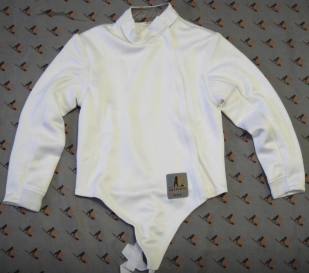
Absolute Fencing Elite Stretch 350 Newton for when you don’t want to be a tank. My longsword jacket is so protective that I don’t even feel that I was hit when Rapier and Dagger fencing or Smallsword let alone using Olympic sports fencing gear. This helps a lot by not restricting movement or being so damn hot to wear. The one problem is that you’re likely to be covered in bruises after a two day tournament wearing this. You can buy it at Absolute Fencing
Destroyer Modz Gorget
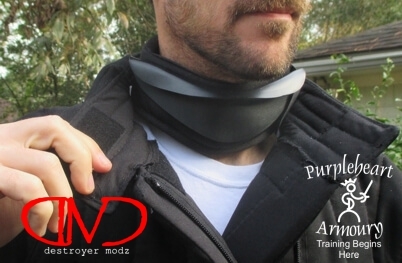
Speaking of built-in gorget in the challenge jacket here is my main gorget (\ ˈgȯr-jət \). This is a very lightweight and simple gorget mainly to be tournament ready or for low gear sparring without the jacket or for singlestick. Many of the different gorget designs can be quite large and substantial which can require modifications for guards when your arms are above your shoulders otherwise they can be restrictive. Since the Challenge Jacket already is very substantial in its protection I chose simple and to be honest relatively inexpensive. One problem I can see is if you have a very large neck the fit is tenuous and I think they would be well served to have a large size. Purpleheart was amazingly fast to deliver this to my door. I expected I’d be lucky to get it in a month or two but it was less than a week. If you’re a Hema Alliance member don’t forget to add your promo code when ordering for a discount.
You can buy it here: Purpleheart Armory Destroyer Modz Gorget.
Gajardoni Custom 800 Newton Breeches
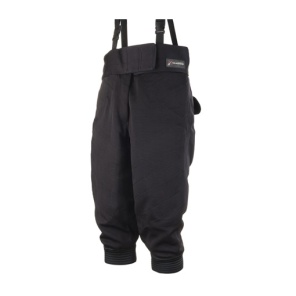
These breeches offer a lot of extra protection most of which I took out like I did with the Jacket. These are custom sized because of my stature but I would recommend bespoke gear in general as the extra cost is worth it even if you aren’t a giant. I supplemented the suspenders that come built-in with Holdup Suspenders as I am a giant and the suspenders are insufficient for the weight of the pants. They are no doubt just fine for your typical Hema enthusiast. The back pocket works well for a wallet or if you’re an Apple Pay/Android Pay type you can carry your phone instead so you don’t have to worry about people “lifting” it while you’re at a tournament. The material is incredibly well made and substantial without the extra modular padding. Some of the padding has a very soft velvet feel which is nice if you need the extra padding because of a wallowing buffel at a tournament.
You can buy them here: Gajardoni Breeches.
K-P Knee Pro Ultra Flex III Knee Pads
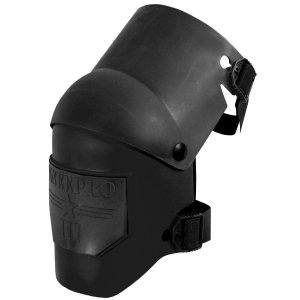
This knee protection works great and is readily available for quick delivery or at many brick and mortar stores. It should fit just about anyone. It covers the side of the knee and is light. It is probably close to indestructible and protects amazingly well. It may be the cheapest, best, and accessible piece of gear in the Hema arsenal.
You can buy it here: Amazon.
Harrow Probot Shin Guard
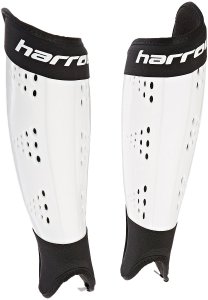
These shin guards work so well with the knee pro that it is magic. They are so much better than my previous set of shin guards. They have soft ends at the bottom to help defend the top of your ankle and not be painful. Once you pull up your socks they stay where they need to be and help anchor your knee protection which should fit and rest at the top of the shins. They don’t need straps or a wrap around which made me wary at first. One negative is that they don’t provide any protection to the back of your calf but they do great on the side of the calf as even with a giant like myself it wraps around pretty far. After use, it should kind of mold to your leg a bit which is nice.
You can buy it here: Amazon.
Compression Socks
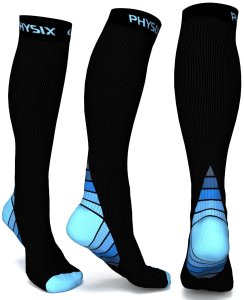
There is very little price difference between getting good compression socks and just normal fencing socks so I recommend compression socks. They also tend to be better constructed and better able to keep shin guards in place. I find they help me last longer on my feet and are great when you have to sit for a long time like a plane trip or road trip to the tournament. They also are supposed to help with a lower recovery time after the event or practice and are good for diabetics. You can buy them pretty much everywhere though I am sure there are quality differences depending on the place.
You can buy one of the types I use here: Amazon.
Forearm and Elbow Protection
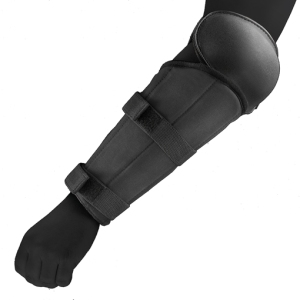
These are solid protections that I received from Gajardoni mainly because it was easy and convenient to just add it to the cart with the rest of the gear but there are plenty of different designs available. These are nice because they fit well over the jacket or without the jacket and my forearms are very large. The built-in elbow protection to the Challenge jacket actually works well to anchor the elbow part of this protector making it very safe from harm. Or since the elbow piece is separate you can undo the velcro and go without the elbow pad. The other good thing is that there are no gaps like a lot of designs running up the inside of the arm. So, good for longsword and good for low gear practice or singlestick.
You can buy it here: Gajardoni Forearm and elbow.
Koning Gloves
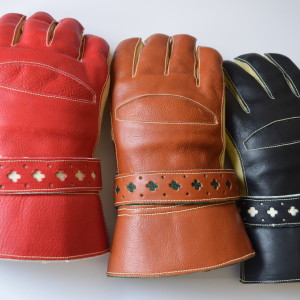
These gloves are very well constructed with a very soft inner leather glove so you can get a good grip and feeling through the glove to your weapon. On the outer part of the glove, the leather is harder and more durable seeming as that is where you’re going to get hit. It has a band around the wrist for extra protection without restricting wrist movement. Sandwiched between layers are rigid plates to protect the hand and in particular the fingers from direct hits by blunt steel blades. These plates can be maneuvered around while you use the gloves and get it prepped for you so the glove gets more tailored to your particular hand as you use it. When you first get the glove it can be hard to even fit your fingers in it but as you stretch it and get it used to your specific hand it becomes quite comfortable. It is very much like getting a baseball glove ready for the season.
It took me about a month of just working the gloves while watching Netflix or Youtube videos on HEMA to get the gloves comfortable.
These gloves are primarily for longsword but unlike most longsword gloves can be used with different weapons making them a good backup for even some rapiers or sideswords should something go wrong with your lite gloves. The wait time from Sweden is substantial though it is improving and now you have the option if you’re in America to get them quickly from Purpleheart Armoury.
You can buy them internationally from here: St Mark.
Kombat Gloves
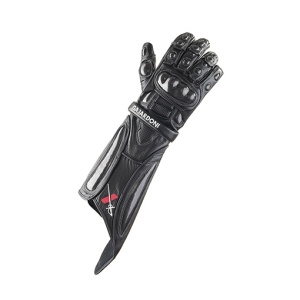
These are very well protecting lightweight gloves good for historical fencing with lighter weapons like sabres, rapiers, singlestick, or daggers. One thing to keep in mind that the extra knuckle protection can with some designs of rapiers make it a bit cramped if your hand is large and space is small. I also have very large forearms so with my jacket it can be difficult for the forearm velcro to fit around but that shouldn’t be a problem for most people. With the Challenge jacket having built-in elbow protection you can use these and not worry about forearm and elbow protection. If wearing without the jacket you can take the elbow part of the forearm protectors I showed above and use them in conjunction with the gloves if you want and if you have the little leather jutting out the end outside of the elbow cup.
You can buy it here: Gajardoni.
Sigi Forge Endurance Feder, Arming Sword, and Buckler
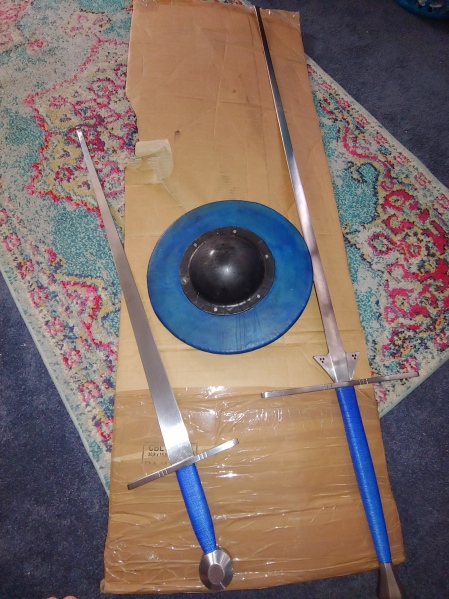
Lovely set triple set from Sigi Forge that I purchased on special before they had their website up and were just using facebook and email for customer service. For durability I chose string vs leather and all blue to differentiate from the ubiquitous all black.
The buckler is made from leather and wood and feels great in the hand and much nimbler than the indestructible cold steel model. Not sure of its durability but it feels tough.
The arming sword is fast and very flexible so thrusts shouldn’t hurt like some of the more i33 focused blades but it also doesn’t have the blade presence in the bind that they have. As always trade offs are the rule.
I chose the Endurance Feder with an S curved hilt, holes punched and the faceted pommel. It has great flex and is pretty long which is great for a big guy like me and feels a bit more thrust-centric in style and is very friendly to your sparring partner by having great flex on that thrust especially compared to some of those crowbars out there. I haven’t had enough time trying it out against live opponents because of the apocalypse sadly but it is fun for backyard play against cat toys, battle ropes, and various balls hung from my clothes line. You can now buy them here: Sigi Forge.
Type III Pentti Synthetic Longsword
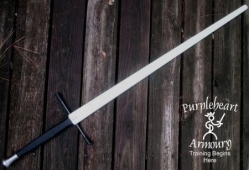
Quick delivery as a surprise Christmas present for me. Well constructed and capable of taking a lot of punishment it is a great practice tool at home. Don’t forget to use your Hema Alliance membership promo code when ordering.
You can buy it here: Purpleheart Armoury.
Purpleheart SingleStick
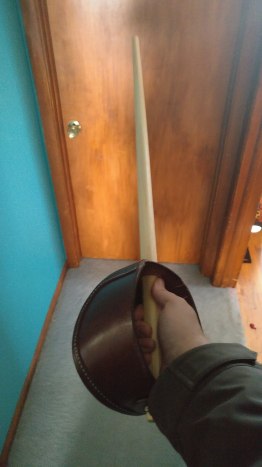
This singlestick is very well made with a leather basket and for a little extra over the standard rattan, I chose the hickory model with the oval shape. It has a nice shape for grip to help with edge alignment so you don’t get in bad habits and has a taper making it feel more alive and responsive in the hand.
I ended up picking up rattan sticks from Purpleheart as the ruleset for the Cornhusker State Games required rattan. Customer service was fantastic and shipped them out in time for me to use them at the tournament.
Pick up some gaffer tape if the sticks don’t fit the top and bottom snugly and you’ll appreciate the improvement and the better grip if you use some on part of the grip itself.
You can buy it here: Purpleheart Armoury
Kraken Swords Smallsword
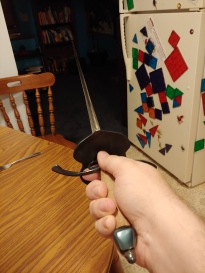
Lovely smallsword with a PoB that is much further away from the guard than most I’ve used before it still handles beautifully. There was some issues with lost and returned smallswords because of the mail disaster of the pandemic so it took a couple of months longer than initially hoped but in the HEMA world that is nothing though sad when you’re excited.
There are tons of cool designs available at Kraken Swords.
Tom Rock’s Smallsword
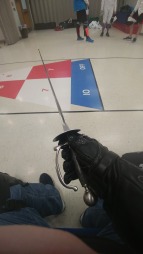
I ordered this smallsword from Tom Rock and I’m quite happy with it. It has a 32″ Epee blade with a wood handle it works just fine. Tom is going to make a scabbard for me which I am looking forward to using if done at the Midwest Pirate Festival and other Renfaire type events.
You can order it here I believe: Hidden Cove Smugglers
Castille Armory Economy Rapier and Dagger
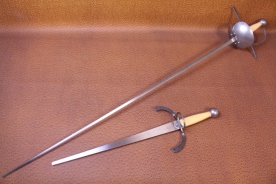
One of the best bargains out there for those getting into rapier and dagger fencing in North America. Customer Service is fantastic both via email and on Facebook. They shipped out in just a few weeks!
Good rapiers are hard to find that is both tough and able to replicate period pieces for the purposes of training. My plan is to get a nicer rapier in a year or two and then I will be able to loan this out to a sparring partner. My club has a lack of rapiers making it hard to train. You can buy them here: Castille Armory
I got to test these out for the first time at the KC Five Rings tournament and they held up admirably. I would have loved to have had the chance to get familiar with them but few people to spar against with rapier and dagger.
I put some felt and leather and used some gaffer tape on the quillons and base of the blade to give my fingers and thumb some padding which helps when you’re at home striking cat toys in the back yard and don’t want to wear gloves. The twisted quillon bar would not be kind to your hand otherwise.
Hanwei Hutton Sabre
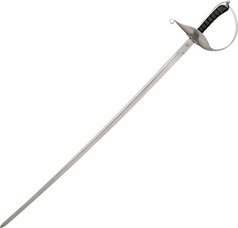
An inexpensive trainer this is the value sabre in HEMA that I only recommend for the price. The guard is not durable and the blade is heavy and short. But, it is inexpensive and it works well enough. If you do a beat with the false edge keep in mind that the metal is quite soft on the back and will get burrs quite easily so maintenance is important.
I had to do a bit of a modification to the grip using two pieces of leather and some gaffer tape to give my pinkie and ring finger a chance to exert the right kind of pressure when pommeling the grip.
When fighting against your kvetun, darkwood, castille, and regenyei sabres it will get chewed up and you will need to buff out the worse of the burrs and dents.
It gets the job done for half or a third of the price but you get what you pay for. It works but you’ll want to upgrade to the better sabres so you have to do that cost-benefit analysis depending on how much sabre you’re doing. I bought it so that when I get a better sabre I’ll use this as a loaner for the club. If you want a great sabre than just skip this and go to the better models.
Amazon
VB Gymnasium Purpleheart Sabre V2
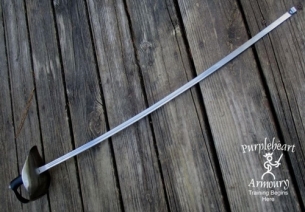
This sabre is light years better in design compared to the Hanwei Hutton above. The POB is several inches farther from the hilt and not as point nimble as the Hutton which has most of the weight in the much larger shell. The edge of the VB sabre is much thicker and rounded so it won’t get nearly as beat up or likely to burr as the Hanwei. The tip is rolled and much thicker and wider comparatively. The build quality is noticeably superior to my Hanwei.
You should place a rubber blunt for safety or wrap it in leather and gaffer tape. I use one of Purpleheart’s rubber blunts you can get in a pack of 4. The weight is only two ounces more than the Hutton but it has a lot more presence in the bind and a beat with a follow up can give you quite the advantage against lighter sabres or you can sometimes just power through a block. The disadvantage is that it is less nimble on the tip for thrusts and for defense against feints and second intents if you’re not thinking ahead.
Instead of using gaffer tape I put some waterproof tape on the end in bright yellow to contrast the Hema black to make it easier for judges and hopefully since it is slick it won’t snag on masks as much as the rubber by itself. So far it seems to be better at skidding off when covering the rubber blunt.
After some use part of the leather grip separated from the material underneath. Will probably get my loctite out at some point and glue it back on or I might get some sort of grip tape to cover.
Buy it in North America at: Purpleheart Armoury.
Cold Steel Synthetic Buckler
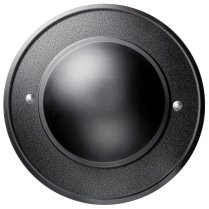
Solid and practically indestructible this buckler is inexpensive and does the job whether using a synthetic or steel blade.
You can buy it here: Amazon.
Cold Steel Rondel Rubber Training Dagger
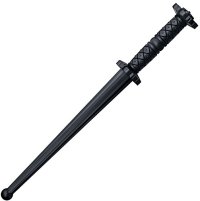
Good and simple practice dagger that has good flex so you can safely stab your friends. Inexpensive and with easy accessibility it is a good addition to your loadout.
You can buy it here: Amazon.
Sisu Mouth Guard

Good to have if you’re going to be doing some boxing, bartitsu, ringen, glima, or just common fencing grappling or wrestling. Don’t want to get your teeth knocked out on accident if you can help it.
You can buy it here: Amazon.
NuttyBuddy Cup and Shorts
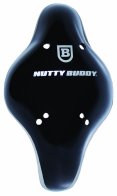
Gotta protect your “nutty” and this combo of shorts and cup works very well. It must take a ridiculous amount of force to break this. A couple of good jockstraps are good to have as a backup in case your lazy and don’t get to your laundry in time.
You can buy it here: Amazon.
Alera Wire Garment Rack
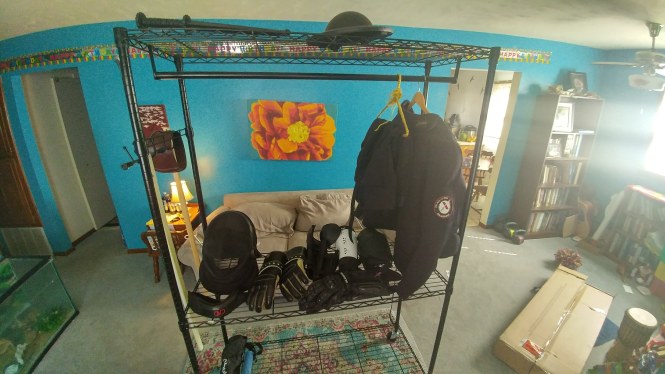
It is nice to have something to hang up your gear to dry it out and just keep it organized. This holds my Purpleheart longsword and singlestick on the left side there very well so it is also a sword rack to add to the convenience. I got it for $55 at Costco.
Mares Mesh Bag
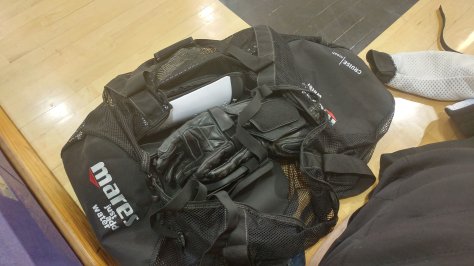
As an upgrade to my snowboard bag, I picked up the mesh bag based on the review at Measure and Weigh. It is really convenient for everything not requiring longsword. Singlesticks fit in fine with no problem. A really nice perk is when you’re trying to find stuff it is easy since the mesh is see-thru. I am a giant so my gear is heavier and larger than most people and I had no problem storing my jacket inside out and all my protective gear so the vast majority of people should have no problems. I bought mine at Amazon.
Exercise Gear:
I get a lot of mileage with my NSD spinner which is fun to do and I think helps build up finer muscle control for strammazone type cuts as you’re making very tight circular motions to get it to spin. If you check out my previous post on exercises you’ll see a link to the one I have.
From Iron Mind I have a Captain’s of Crush Trainer, #1, #1.5, #2, and #2.5 grippers, a Blue Iron Egg, and I had their elastic bands but today I mostly just buy bulk broccoli bands on amazon because the half dozen extensor stretching tools I’ve tried have all broken fairly quickly and the broccoli bands are cheap enough that when they break it doesn’t really matter.
The CoC Trainer is good for reps a couple of times a day for building your grip strength which is important for sword work and for things like the bench press. If you want to push your grip strength get an additional gripper of higher tension like the #1 or go with the #.5 if you have difficulty with the Trainer and use that to step up the difficulty so you always have something beyond your current capability. The Iron Egg I squeeze while reading a book or watching a video and same with the elastic bands which are fun for building your forearm and fingers and can help with an injury.
The Gripmasters I use at work though I have destroyed them pretty badly. I have the 9 pounds and the 11 pounds and if you do the pinch grip it will give you a good workout for your fingers. Great for building your bass playing skills especially the pinkie and of course your grip for Hema.
The Theraband blue is good for if you get tennis elbow and for your grip do a pickup grip on the tips of the band and twist and that will get your whole forearm and fingers working.
Resistance bands are good for increasing your leg strength and are really interesting to use when practicing careful short lunges, voids, and traverses while you have them at your ankles.
Battle ropes are fun and I get double use out of my makeshift pole/pell.
I have a Valeo medicine ball which is good for working out your core and I like to lay down and throw it up with my right arm like I am punching out or making an oberhau. Exercising the lazy way while listening to a podcast or youtube video drone on is a-ok with me.
I will do kettlebell exercises while watching Hema youtube videos on pc or while lazing on the couch watching Netflix or amazon prime. I have wide grip kettlebells which are good for building your grip strength.
Balance pads and agility ladders are good to help get your feet moving and your balance better which is a huge part of any martial art and will help you get better at dancing too!
I have some boxer stringed balls I use outside to help with point work and thrusts hanging from the clothesline.
Wishlist/Waitlist:
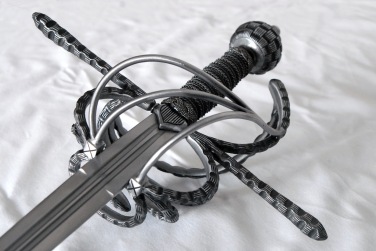
For my steel rapier and dagger, {edit: updated} I was on the waitlist for a Danelli Armouries rapier for a year or so but Marco closed down his shop. The rapier above is one of his most beautiful though way out of my price range. His website: Danelli Armouries. If you’re in the market for a high-end rapier they are still being made over at Balefire so check them out and Castille has some amazing bronze custom blades.
I am excited at seeing Castille’s new highland broadswords and their sideswords from the economy line. Very tempting!
I am waiting for my Spes Officer Jacket so I can have something for the heavy sidearm class of weapons because my longsword jacket is to thick and hot and my sports jacket is too thin and I get bruised up pretty bad after a weekend tournament.
Summary
I decided to make this blog to help people see some of the choices that another fencer had made so that my decisions and reviews might help them make better choices for them. I hope you found it useful and enjoyed your time here.
Here is my Amazon Idea List I made of HEMA gear and books available there.
My previous articles on Hema:
A Novice’s Guide to HEMA: Websites to Buy Swords and Equipment
A Novice’s Guide to HEMA: Tournaments
A Novice’s Guide to HEMA: Historical European Martial Arts
A Novice’s Guide to HEMA: One Year Anniversary Update Post on Historical European Martial Arts
A Novice’s Guide to HEMA: Novel Exercises and Solo Drills for Historical European Martial Arts
A Novice’s Guide to HEMA: My HEMA Loadout and Wishlist
A Novice’s Guide to HEMA: Cat’s Nine Lives Halloween Tournament








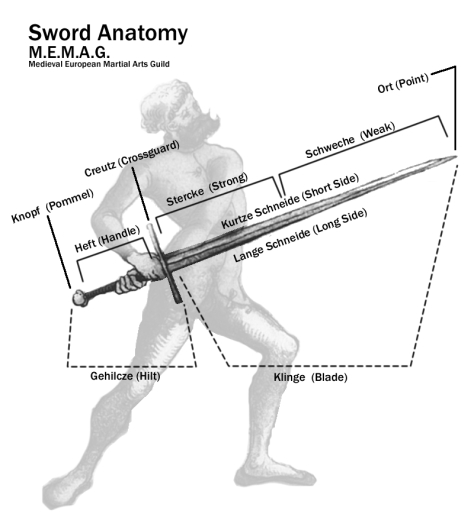














 This is my main jacket as of 2020 that I use for fencing practice. With longsword I make sure I use my forearm protectors otherwise bruises are going to be bad. It is much lighter than my Gajardoni and doesn’t generate nearly the same amount of heat. It is also quite stylish. It has a zipper and buttons on the front which is way easier to handle than the back zipper on the Gajardoni. It is perfect for sabre/backsword/broadsword. There is a newer model 2 now for an extra 100 USD. You can buy it here at
This is my main jacket as of 2020 that I use for fencing practice. With longsword I make sure I use my forearm protectors otherwise bruises are going to be bad. It is much lighter than my Gajardoni and doesn’t generate nearly the same amount of heat. It is also quite stylish. It has a zipper and buttons on the front which is way easier to handle than the back zipper on the Gajardoni. It is perfect for sabre/backsword/broadsword. There is a newer model 2 now for an extra 100 USD. You can buy it here at 


























